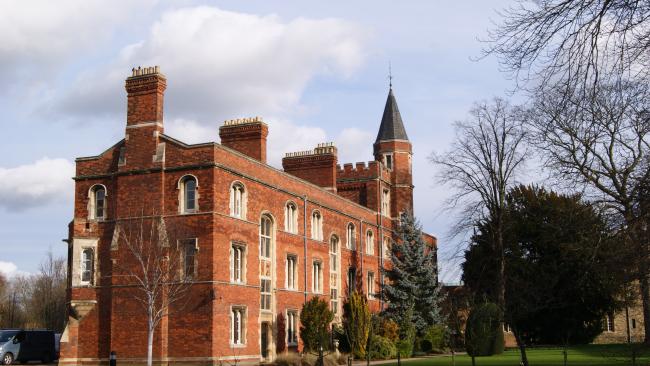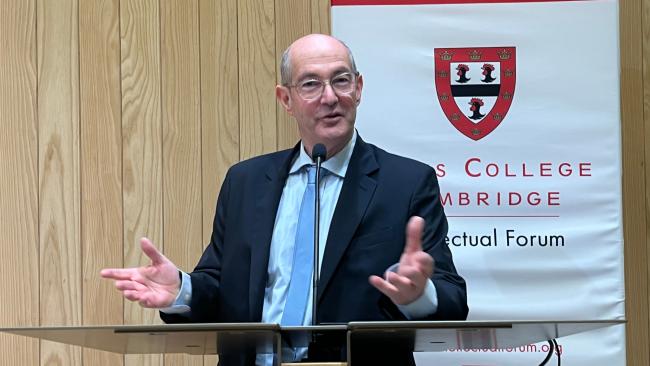
CISL students advise Jesus College on improving the sustainability of historic estate
Students from the MSt Interdisciplinary Design for the Built Environment (IDBE) course run by the Cambridge Institute for Sustainability Leadership (CISL) have been working with Jesus College to help us consider how to manage our historic estate to achieve ambitious sustainability targets.
One of the areas of focus for IDBE students is ‘Heritage Environments’, looking at the social, environmental and economic value of heritage properties and the challenge of retrofit. Jesus College provides an ideal example of these opportunities and challenges. Established in 1496, our estate includes examples of architecture from the 12th to the 21st centuries. Many of our properties contribute to the rich heritage of the city and are listed as Grade I and Grade II.
Jesus College aims to be recognised globally as a leading academic institution where sustainability is intrinsic through engagement, collaboration and innovation. We have already implemented a number of initiatives including solar thermal panels, a ground source heat pump and LED lighting. The Catering team is growing the sustainable food offering, reducing the volume of ruminant meat used and working with students at finding ways of minimising food waste. The student community encourages behavioural change via their ‘Sustainability A to Z students’ guide’ and College leaders are actively involved in a number of environmental committees within the University of Cambridge.
Kayla Friedman, IDBE Course Director, said: “Jesus College represented a fantastic opportunity for our students to explore the possibilities for investment across an interesting portfolio of properties. It may cost more upfront to make significant changes to windows, walls, heating and lighting systems but these changes are worthwhile when you look at the savings made over 50 years. The College was very receptive to our suggestions and our students will be interested in following its progress towards its sustainable goals for the future.”
Domestic Bursar Stuart Websdale welcomed the opportunity to collaborate with CISL and the IDBE. He worked with the CISL students by providing the history and background details of the project sites and he outlined the College’s sustainability plans. The students, who are all part-time professionals from across different built environment disciplines, split into six teams to work on different types of projects owned by the College. Initially, they planned to spend every afternoon for a week on site during their residential week in Cambridge. Due to COVID-19 however, the project became a virtual one and all research and feedback was provided in digital formats.
Amna Bin Thaneya is a Development Architect at Joint Ventures and is studying for an MSt in Interdisciplinary Design for the Built Environment at CISL. She said: "Hopefully, the work will set a benchmark for all students on the importance of utilising sustainable and energy conscience solutions into any development whether in retrofit projects or new construction."
Athena Chau is a practising architect from Hong Kong. She said: "I hope to set a good example of how we can bring a sustainable redevelopment, while preserving the heritage value of the architecture.”
Stuart Websdale said: "We were delighted to welcome involvement from CISL students in our plans to become more sustainable in the future. They understood the challenges and opportunities of making improvements to our older buildings, and they came up with some innovative suggestions, many of which we will incorporate into our renovation plans. This project is one of many initiatives at Jesus College to develop our Sustainability Strategy through engagement, collaboration and innovation.”
Student proposals by project
The Estate Strategy
One student team looked at the overall framework to Jesus College becoming net carbon zero across the estate. They recognised that achieving sustainability goals would mean setting clear abiding principles to guide all College projects, and embedding a new culture throughout the College to change behaviour. They outlined the overriding project principles of heritage preservation, long-term thinking, College culture, information management, stakeholder engagement and working in line with the UN Sustainable Development Goals. They suggested that the key pillars of design should be power, waste, transportation, water and people and they suggested possible elements of a road map towards achieving the ambitious goals of the College.
Jesus Lane
Two example residential properties on Jesus Lane are Grade II listed, two-storey residential buildings containing 12 student bedrooms in total. The team made proposals aiming to maintain the heritage value and charm of the properties, while upgrading their sustainability performance to work towards the aim of becoming net carbon zero. They suggested:
- Installing cavity walls to improve thermal and acoustic performance
- Installing double-glazed windows to improve air-tightness
- Replacing the existing boiler with a ground source heat pump and building management system
- Replacing one of the two staircases to the en suite bathrooms with a fire-rated, protected lobby which would create a more open and flexible floor plate while providing additional space for shared amenities per floor.
- Recycling grey water for gardening
- Restoring an internal part-original grey Gault brick wall
- Introducing renewable energy using photovoltaic panels, a wind turbine generator for a garden lamppost and an electric bicycle charging point for the community.
Elm Street Living
Elm Street Living is a new development proposed to be built on a site currently used for garages, within Kite Street Conservation Area in the historic centre of Cambridge. It is proposed that 9 new homes (3 x 1 bedroom and 6 x 2 bedroom) could be built from recycled materials to a high standard of sustainable living with net carbon zero emissions. They would include courtyard gardens, cycling storage and communal spaces and would be designed to complement the existing architecture of the local area. The students looked at key principles that could be used when designing new buildings within existing historic contexts. As part of the exercise, the students were not privy to existing proposals that have been developed for the site.
19-44 Lower Park Street
The properties of 19-44 Lower Park Street are currently used for postgraduate family accommodation. Early 19th century, Grade II listed terraces, they are small and inefficient with energy usage, but their design adds to the value and charm of the central conservation area of Cambridge. The team of students suggested a number of ways and options that could be considered to improve energy performance, while respecting the historic character of the buildings:
- Improvements to insulation would prevent the loss of heat energy through the roof, solid masonry walls and poor fitting doors and windows
- Shared living spaces could be introduced to maximise use of space, for example shared kitchens, outdoor courtyards or allotment areas
- A basement beneath the existing houses could allow ground source heating and provide extra living space
- A radical approach could involve encapsulating the terraces in a larger glass house to promote a fully tempered climate, and to preserve the existing historic fabric with minimal direct interventions.
The Waterhouse Building
Constructed in the Tudor style in 1869-70, the Waterhouse Building was originally designed by Alfred Waterhouse for student accommodation during a time of huge expansion for the College. This demand for accommodation is now met elsewhere on the estate, freeing the building for possible development into a contemporary and energy efficient workspace for administrative staff. The team made the following suggestions:
- Smart meters and sub-meters are recommended to gather sufficient energy data to monitor progress towards net zero. Smart building technology is also suggested to help maximise the efficiency of the operation of the building.
- Discretely open up the internal floor plate through the use of archways to provide a more open plan feel, whilst preserving the external character of the building. Bathrooms are included on each floor with showers being provided on the ground floor.
- To enable disabled access to the upper floors, an external lift shaft could be installed in keeping with the design of the building, like the one at Westminster Abbey. The lift shaft is proposed to be made from sustainable CLT material, and the lift itself will incorporate energy recovery technology.
- To improve the energy performance of the building, internal insulation will be installed throughout and the windows will be replaced with streamlined single pane double glazed windows. In addition, it is proposed that a ground source heat pump will be installed, along with solar panels on the roof and on the car ports within the car park. Rain-water recycling is also recommended.
- The fit-out is recommended to include elements of biophilia throughout. The lighting should all be LED and PIR controls, circadian lighting and task lighting should all be considered. The furniture used should either by re-used from the current office provision or should be refurbished. Any materials installed should be low VOC materials, and the supply chain of those materials should also be looked into.
- To ensure accurate and reliable waste data, the team proposed the use of sensor technology. The sensors are installed into the bins and measure the fill level which is then converted to a volume measurement.
- Enlarge the current cycle storage and make it lockable. Within the car park, install a solar PV car port with integrated car chargers. Include dedicated car-pooling spaces at the front of the car park and instigate step challenges to promote walking.
The Quincentenary Library
The Quincentenary Library occupies a site that was formerly the kitchen garden of the Master's Lodge. It was designed by architects Eldred Evans and David Shalev, and was officially opened by the Queen in March 1996 to commemorate the 500 year anniversary of the foundation of Jesus College. The team suggested ways to improve the thermal comfort of the building, whilst working towards net zero emissions and enhancing biodiversity:
- Upgrades to the Library entrance and doors could include making sure the outer door is closed before the inner door opens, to retain heat.
- Improvements to fenestration would involve checking the integrity of all windows and repairing as necessary.
- Lighting improvements would mean reviewing the current daylight controls and switching to LED bulbs where possible
- Ventilation improvements could involve checking the integrity of roof vents and repairing as necessary, upgrading the motors and switching from battery to mains power. A mechanical ventilation system could be installed.
- Introduce a Ground Source Heat Pump as a sustainable means of providing heating and cooling to the Library.
- Install solar panels on the roof, used to generate electricity for GSHP operation.
- The College should use a framework to assess the desired goals and needs for biodiversity.
In response to the reports, Stuart Websdale said: “We are excited about the opportunities outlined by CISL’s IDBE students to improve our sustainability and work towards the goal of a carbon neutral estate.”





